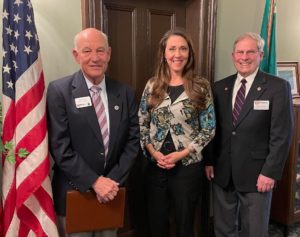TAKE ACTION NOW–
GO TO MOAA’S LEGISLATIVE ACTION CENTER
USE THE FOLLOWING LINK OR GO TO: WWW.MOAA.ORG/TAKEACTION
https://moaa.quorum.us/
The following table shows how chapters in Washingtonian State compare to other chapters based on how many actions were taken using MOAA’s Legislative Action Center during 2024:Washington MOAA Legislative Action Center Engagement
|
|||||
| 1/10/2025 | |||||
| This document details registrants and activity on MOAA’s Legislative Action Center from January 1- Dec 31, 2024 for Washington. | |||||
| State activity reflects the self-reported details provided by registrants through | |||||
| the Legislative Action Center’s registration form. | |||||
| Total Registered Advocates: 954 (278/29% from Chapter or Council Members) | |||||
| Total Actions Taken: 5272 (1982/38% from Chapter or Council Members) | |||||
| Council/ Chapter | Approx # of members in chapter | Number of MOAA LAC Registrants | Number of Actions Taken | Approx # of actions per Registrant member * | Est # of issues * |
| WA00 – Washington State COC | 13 | 56 | 4 | 19 | |
| WA01 – Columbia River Chapter | 80 | 33 | 214 | 6 | 71 |
| WA02 – Kitsap Chapter | 120 | 30 | 356 | 12 | 119 |
| WA03 – N Central Washington Chapter MOAA | 40 | Less than 10 | 18 | 6 | |
| WA04 – Olympia Area Chapter MOAA | 140 | 34 | 260 | 8 | 87 |
| WA05 – Olympic Peninsula Chapter | 60 | 17 | 202 | 12 | 67 |
| WA06 – Seattle Chapter of MOAA | 60 | 25 | 60 | 2 | 20 |
| WA07 – Spokane Chapter ** | 170 | 29 | 81 | 3 | 27 |
| WA08 – Mt Rainier Chapter | 80 | 20 | 102 | 5 | 34 |
| WA10 – Whidbey Island Chapter | 65 | 60 | 601 | 10 | 200 |
| WA11 – Lewis & Clark Chapter | 25 | 12 | 32 | 3 | 11 |
| * computed number from data in this chart | |||||
| ** Spokane mails pre-written letters each month that members and spouses sign at meetings | |||||
Columbia River MOAA Foundation and its Scholarship and Support the Troops Funds Recap
In 2024 the Scholarship Fund:
- Made the final payment to create our endowment at WSU-V, which we will continue to grow toward sustainment in 2025.
- Funded our $1,500 scholarship for a veteran-student at WSU-V
- Funded our three $1,250 scholarships for veteran-students at Clark College
- Took advantage of two matching opportunities to grow the value of our Clark College MOAA CRC Endowment closer to sustainment
In 2025 we will focus on funding the scholarships and growing both endowments.
In 2024 the Support the Troops Fund:
- Donated $250 each to the two local High School AFJROTC programs
- Donated $1,000 to support the food service at the Veterans Stand Down sponsored by Clark County
- Veterans Assistance Center (CCVAC)
- Purchased ceremonial/parade flags for the local Young Marines Program
- Purchased ceremonial/parade flags for the local Sea Cadets Program
- Supported the Vancouver Fisher House and the VA Lodge ($1,000 each)
- Donated $500 to Clark College Veterans Center of Excellence
In 2025 we will focus on supporting the above organizations as they support Veterans, as well as similar other organizations as we are able to identify a need.
FY2025 NDAA: Legislative Activity Report January 8, 2025
https://crsreports.congress.gov/product/pdf/IN/IN12405





FY2024 NDAA sent to President with largest active duty pay raise in two Decades:
NDAA goes to President with largest active duty pay raise (5.2%) in two decades
********************************************************************
One of MOAA’s top on-going Legislative Bills per Lt Gen Kelly at Portland, OR at Dec 5, 2023 meeting with Portland and Columbia River Chapters including OR and WA council members: Passing The Richard Star Act HR 1282 / S 344. Passage of this bill would reverse an unjust offset which requires combat injured retirees to give up one dollar of retirement pay for every dollar of VA disability pay. This is like the unjust “Widow’s tax” (SBP/DIC offset) was that was finally reversed after decades of advocacy.
(Note. Both WA Senators, Murray and Cantwell, and our 3rd US District Congresswoman, Marie Gluesenkamp Perez, have cosponsored their respective bills. However, we must keep advocating unceasingly until it becomes law.
Use the MOAA Legislative Action Center to have your voice heard to pass this bill: https://moaa.quorum.us/campaign/43784/
**********************************************************************




MOAA’s Advocacy Campaign to Target TRICARE Pharmacy Cuts, Housing Costs
Council Presidents will be Washington DC on April 25th & 26th, 2023
meeting will all 12 US Representatives and both Senators (and/or their Legislative Assistants)
during MOAA’s 2023 Advocacy in Action
More to follow SOON on how YOU can help !
MOAA’s Legislative Priorities for the 118th Congress

Want to an easy way to contact your Members of Congress on major issues?
Then use MOAA’s New Easy to Use LEGISLATIVE ACTION CENTER (just click on this link): https://moaa.quorum.us/
———————————–

⇒ ⇒ ⇒ Help us with our Advocacy in Action in April
Use the MOAA Legislative Action Center to contact
Congresswoman Jaime Herrera Beutler, Senators Murray and Cantwell
Issues: Richard Star Act HR 1282 & S 344 Combat Injured Concurrent Receipt
4.6% active duty pay raise
and HR 4824 Stop Copay Overpay Act
———————————–
MOAA’s 2022 Legislative Priorities
MOAA’s 2021 Legislative Priorities
December 29, 2020
(A version of this article originally appeared in the January 2021 issue of Military Officer, a magazine available to all MOAA Premium and Life members. Learn more about the magazine here; learn more about joining MOAA here.) By MOAA Government Relations Staff
Here are MOAA’s priorities for advocacy as the 117th Congress begins its work. Our focus remains on all eight of the uniformed services and their service-earned entitlements.
As protecting health care and service-earned benefits continues to be a challenge, MOAA will press forward in engaging Congress to shape outcomes in these vital areas.
There are steep hills before us. Our nation has a rising debt of more than $27 trillion, and a deficit of more than $3 trillion. In view of this, MOAA anticipates robust attempts to control federal budgets, reduce or eliminate unprogrammed expenditures, and reduce entitlements.
MOAA needs you to be at the ready to reach out to your legislators, and keep that engagement going as needed to make sure your voice is heard.
Our priorities may be updated, as warranted, during the next two years this Congress is in session. Together, we can succeed.
Click one of the links below to go directly to each objective, or scroll down for the full list.
- Recognize the COVID-19 Pandemic Changed the Landscape for Many of Our Priorities
- Protect the Value of the Military Health Care Benefit
- Protect the MHS Pharmacy Benefit and Achieve Flexibility in TRICARE Pharmacy Copays
- Address Barriers to Accessing Care Within the MHS, Including TRICARE Coverage Gaps and Mental Health Care Access Challenges
- Achieve Concurrent Receipt of Service-Earned Retirement Pay and VA Disability Pay
- Protect Family Support Programs, and Ensure Military-Provided Services (Housing, PCS, Child Care) Are Affordable, Readily Available, and Meet Quality Standards
- Reform the Presumptive Process to Support Veterans Claiming Service-Connected Disabilities for Toxic Exposures
- Achieve Equity of Benefits, Protections and Administrative Support for Guard/Reserve Members Consistent With Their Active Duty Counterparts
- Sustain Veterans Health Administration (VHA) Foundational Missions and Services
- Protect Arlington National Cemetery as an Option for Those Currently Eligible to Receive Full Military Honors, Through Expansion of Our National Cemetery
- Sustain Pay Raises for Servicemembers and COLA Raises for Retirees
- Improve Survivor Benefits
- Ensure the Coast Guard Receives Pay During a Government Shutdown
2020 Chapter Legislative Affairs Activity
While the chapter supported the Council President’s Virtual Storm the Hill activity in May 2020, there were no in-person visits to Members of Congress’ local offices, although there were many e-mails between Senator Murray’s Vancouver office staff and our chapter. We have coordinated plans with her office to meet (via ZOOM if necessary) after the President’s 2021 budget is submitted to Congress.
MOAA’s 2020 Legsilative Goals
Previous Meetings with Legislators



The Truth about What Military Beneficiaries Pay
2019 issue paper Military Pay and Benefits 2019 STH Issue Paper
2019 Storming SBP_DIC 2019 Issue Paper
MOAA 2019 Legislative goals


Issue Paper on Chapter 61 Retirees
PROTECTING YOUR PAY AND BENEFITS: MOAA’S 2018 ADVOCACY MISSION

MOAA’s advocacy team is gearing up to protect your health care and retirement benefits, military pay, force levels, wounded warriors, and caregivers.
After an unpredictable 2017, the coming year likely will hold even more surprises on Capitol Hill. Midterm elections are coming in November, and the turnover in Congress could be significant. With partisanship on the rise, the political transition likely will pose interesting challenges.
Our uniformed servicemembers and their families have now endured 16 years of war. Overshadowing the challenges is the constant competition for fewer dollars, as budget caps dominate discussions at every level.
These growing budget pressures prompt efforts to erode service-earned benefits through reduced pay raises, significant changes to housing allowances, and increased health care fees. While MOAA has successfully deflected some of those challenges, we must remain vigilant. Of paramount concern is the proven impact these reductions have on retention and readiness. We’re resolved to ensure any reduction to career incentives – essential to the all-volunteer force – is approached with great care.
For more about how to join MOAA and our advocacy efforts, click here.
ONE
Action item: Ensure any TRICARE reform sustains access to top-quality care and avoids disproportional TRICARE fee increases.
Who is affected? All military beneficiaries, including active duty troops and retirees and their family members and others entitled to DoD’s health care
The issue: Reforms to the Military Health System must sustain an operationally ready force with a ready medical force. MOAA strongly agrees the military’s health care system needs to evolve beyond what it is today into a modern, high-performing, integrated system. However, this interdependent relationship between health care and the readiness-laden infrastructure must not lose sight of either imperative. The health care benefit is a commitment our nation makes to servicemembers and their families, military retirees, and survivors for their years of service. Any reform of TRICARE must take into account the decades of service that constitute a prepaid, in-kind premium worthy of a top-tier health benefit. Over 80 percent of those in Congress have not served in uniform and likely do not understand the toll service has on individuals and military families.
The remedy: Personal stories from constituents have a lot of impact on Capitol Hill. MOAA’s members, councils, and chapters are a great source of grassroots support. Remind congressional legislators that any TRICARE reform not only must serve to strengthen the interdependent relationships between health care and readiness but also take into account that veterans prepaid for their health benefits through decades of service and sacrifice.
TWO
Action item: Sustain military pay comparability with the private sector.
Who is affected? All active duty currently serving uniformed personnel and their families
The issue: Budget pressures might tempt Congress to reduce military pay raises, widening the gap between military pay and civilian-sector pay and hurting recruiting and retention.
The remedy: We must work to ensure annual military pay raises approved by Congress remain tied to the Employment Cost Index.
THREE
Action item: Block erosion of compensation and non-pay and quality-of-life benefits.
Who is affected? All currently serving uniformed personnel and their family members
The issue: Future proposals likely will reduce the value of compensation, to include non-pay and quality-of-life benefits such as the Basic Allowance for Housing, Special Incentive Pays, and commissary, exchange, and morale, welfare, and recreation benefits, harming recruiting and retention.
The remedy: MOAA will continue to oppose proposals to reduce the value of compensation or undermine long-term retention.
FOUR
Action item: Protect military retirement and COLAs.
Who is affected? All new entrants into military service after Jan. 1, as well as those with less than 12 years of active military service who choose to opt in to the new blended retirement system (BRS)
The issue: Budget constraints might lead to further reductions in the value of the military retirement benefit earned after 20 years of service.
The remedy: Extend the period of government matching funds beyond 26 years to actual retirement. Oppose any efforts to reduce or eliminate the mandatory 12-years-of-service bonus in the BRS. Continue to seek comprehensive implementation of legislation authorizing concurrent receipt of uniformed service retired pay and VA disability compensation, to include a heightened focus on Chapter 61 retirees (those medically retired with less than 20 years of service).
FIVE
Action item: Sustain wounded warrior programs and expand caregiver support.
Who is affected? More than 52,000 servicemembers who were wounded in action, 1,000 battle-injured with major limb amputations, 327,000 traumatic brain injuries, and hundreds of thousands of individuals with service-connected conditions acquired since Sept. 11, 2001
The issue: While DoD, the VA, and the military services continue to maintain programs to care and support our most vulnerable servicemembers, MOAA has seen reductions in resources and funding for these programs.
The remedy: MOAA is committed to moving DoD and the VA to establish a more unified and integrated system of care and benefits that will provide comprehensive, wrap-around services to facilitate the health and well-being of the nation’s wounded, ill, and injured. The Military and Veteran Caregiver Services Act of 2017, sponsored by Sen. Patty Murray (D-Wash.) and Rep. James Langevin (D-R.I.), is one step in that direction.
SIX
Action item: End financial penalties to disabled servicemembers.
Who is affected? Veterans with service-connected injuries
The issue: Veterans forced into disability retirements before completing a full career (also known as Chapter 61 retirees) are prohibited from receiving military retired pay concurrently with VA disability compensation.
The remedy: Sen. Dean Heller (R-Nev.) and Rep. Sanford Bishop (D-Ga.) have introduced legislation – S. 66 and H.R. 333, respectively – to expand concurrent receipt for disabled retirees.
SEVEN
Action item: End financial penalties to survivors.
Who is affected? Military survivors
The issue: Military survivors whose sponsors died of service-connected causes suffer from the widows tax, a dollar-for-dollar offset of DoD’s Survivor Benefit Plan (SBP) from the VA’s Dependency and Indemnity Compensation (DIC).
The remedy: Sen. Bill Nelson (D-Fla.) and Rep. Joe Wilson (R-S.C.) introduced legislation – S. 339 and H.R. 846, respectively – to eliminate the SBP-DIC widows tax.
EIGHT
Action item: Ensure the Guard and Reserve system adequately supports requirements for an operational reserve.
Who is affected? Members of the reserve components and their families
The issue: Members of the Guard and Reserve community have proven their mettle many times over during the past 16 years of armed conflict. Meanwhile, the paradigm for reserve component usage has changed from a strategic reserve to a combat-ready warfighting element incorporated into current and future war planning. As the demands on Guard and Reserve troops have evolved, so has the need for benefits comparable to their active duty counterparts.
The remedy: MOAA will continue to work with Congress to generate and support legislation strengthening legal protections for Guard and Reserve members in their civilian employment and in consumer contracts.
NINE
The issue: Recruiting and retention of an all-volunteer force require alignment of spouse and family support programs.
Who is affected? Every servicemember who has or will have a family
The issue: The decision to remain in service often is made around the kitchen table and considers the evolving needs of the entire family, including the employment, educational, and health care needs of non-serving family members; access to child care; and the frequency of relocations.
The remedy: Decrease the military spouse unemployment rate, which remains four to six times higher than the national rate. Increase the synergy between family support and health care systems, along with initiatives to address schools lacking appropriate resources to keep mobile military children on track.
TEN
Action item: Ensure timely access to VA health care and preserve veterans’ earned benefits.
Who is affected? There are 21 million veterans in the U.S., with 6.7 million receiving care from the Veterans Health Administration.
The issue: The demand for VA health care and benefits continues to grow, even as the agency has received insufficient funding from Congress and faced frequent proposals for budget cuts.
The remedy: MOAA continues to press for VA health care and benefit system transformation, including investments in technology, financial systems, and infrastructure.


Evelyn and Dave also met with Dave Hodges and Bryan Stebbins in Senator Murray’s SW Washington office to discuss the same issues.
MOAA’s Top 10 Goals for 2017
MOAA published their Top 10 legislative goals for 2017 which are listed below. These are the issues about which we can expect to be asked to respond to Legislative Alerts concerning. Storm the Hill is scheduled to be a little earlier this year (first week in April) and will likely focus on two or three issues in the top five.
-
Remove the Sequester
-
End disabled/survivor financial offsets and penalties
-
Ensure TRICARE reform sustains access to and performance of top-quality care
-
Prevent disproportional TRICARE fee hikes and inordinate program changes
-
End military pay-raise caps and restore pay comparability with private sector
-
Guard against erosion of earned compensation and commissary benefits
-
Sustain wounded warrior programs and expand caregiver support
-
Credit Guard and Reserve call-ups for retirement purposes
-
Improve and sustain spouse and family support
-
Assure timely access to VA care and eliminate claims backlog
Note. This list came from page 36 in the January issue of Military Officer Magazine
US DEPARTMENT OF VETERANS AFFAIRS–SECRETARY MCDONALD CABINET EXIT MEMO JAN 5, 2017
Secretary McDonald VA-Exit-Memo
FY17 NDAA SASC Summary–Senate Armed Services Committee
FY17 NDAA Bill SASC Summary
August Recess
August 23, 2016


President Evelyn Brady, 1VP Jeremy Baenen and past president Dave Casteel met with Senator Murray’s and Congresswoman Herrera Beutler’s staffs to discuss:
FY17 Defense Authorization Bill Key Issues
-
ISSUE #1: Reject Military Housing Allowance Cuts
-
ISSUE #2: Troops Deserve Full Pay Raise and Force Increases
-
ISSUE #3: Oppose Disproportional TRICARE Fee Hikes
-
ISSUE #4: Reduce Military “Widows Tax,” Don’t Just Maintain It (We thanked Senator Murray for co-sponsoring SB 979, and asked Congresswoman to please co-sponsor House equivalent bill HR 1594)
2016 Storm the Hill
April 11:
Maj Gen Les Burger, MD, USA, Ret, and President Evelyn Brady and Past President Dave Casteel met with Senator Murray’s Veterans Affairs assistant Bryan Stebbins to discuss two main issues:
-
Military health Care Reform
-
End Unfair Military “Widows Tax” (i.e., SBP-DIC Offset)
-
We discussed and left behind these two MOAA Brochures:
April 8
Past President Dave Casteel called Senator Cantwell’s Veterans Affairs assistant, Sam Mack in Tacoma office to discuss:
-
Military health Care Reform
-
End Unfair Military “Widows Tax” (i.e., SBP-DIC Offset)
-
He e-mailed these two MOAA Brochures:
MOAA Legislative Goals for 2016
2015 Storm the Hill
April 2015
April 14, President Casteel visits the offices of Senator Murray and Cantwell, and Congresswoman Herrera Beutler dropping off Storm the Hill Point Papers and Brochures
President Casteel notifies chapter membership of Storm the Hill dates and issues and asks them to call MOAA toll free capitol hotline to support our Council and national MOAA staff.
February 2015
Maj Gen Buck Marr and Chapter President, Dave Casteel meet with Senator Murray’s staff to discuss President’s Budget and MCRMC



Casteel and Chapter Legislative Affairs Chair Roy Korkolo meet with 3rd US Dist Congresswoman Jaime Herrera Beutler September 2014 to discuss FY15 Def Auth Act and issues in the Act affecting our service members
